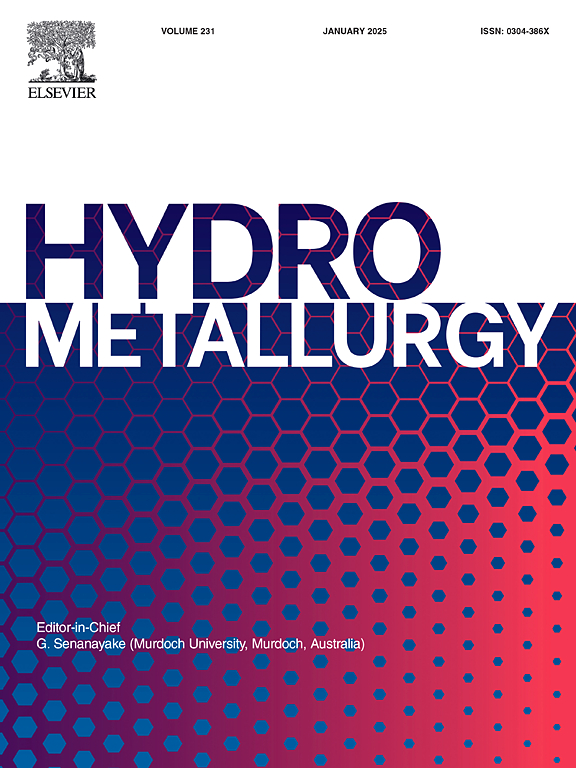Usage of inorganic polyoxometalates of tungsten for extraction of rare earths in an aqueous two-phase system (ATPS): Preliminary results
IF 4.8
2区 材料科学
Q1 METALLURGY & METALLURGICAL ENGINEERING
引用次数: 0
Abstract
The extraction of rare earth elements (REEs) such as YIII, LaIII, PrIII, NdIII, EuIII, TbIII, DyIII, ErIII and YbIII in aqueous two-phase system (ATPS) formed by PEG/MgSO4 and polyoxometalates (POMs) as extractants was investigated under various conditions. Increased vacant sites in the POM and higher POM concentrations enhanced the competitive effect among REEs extraction. Lower acidity also enhanced the effect, and the extraction depended on the initial REEs composition. Optimal separation was achieved at 8.8E-4 M REE mix solution, 67.5 molar ratio HCl: REE, 3:1 molar ratio of Na10[SiW9O34]: REE and 25 °C, achieving 52 % extraction for Tb and an average selectivity of 2.1. The extraction trend followed the REE atomic number, except for Y. The stripping of REE from the light phase was done by precipitation using tetraethylammonium chloride. The ICP and FT-IR techniques indicate stripping of REE: POMs complexes and REE: hydroxosulfate complexes according to OH− in the system. The stripping of REE in the first complexes follows the same trend as in extraction, and the second type offers selective stripping of LaIII, PrIII, NdIII, EuIII as a group. Furthermore, continuous flow experiments using microreactors were conducted, varying reactor lengths and flow-rates based on batch test conditions. Fluctuations were observed in all cases, likely due to mass transfer between phase-forming compounds, resulting in wavy core-annular flow. The small discrepancies with batch experiments demonstrate the feasibility of continuous extraction using ATPS and POM as extractants.

无机钨多金属氧酸盐在两水相萃取稀土中的应用:初步结果
研究了以PEG/MgSO4和多金属氧酸盐(POMs)为萃取剂形成的两水相体系(ATPS)中稀土元素(稀土)YIII、LaIII、PrIII、NdIII、EuIII、TbIII、DyIII、ErIII和YbIII的萃取。POM中空位的增加和POM浓度的升高增强了稀土元素提取的竞争效应。较低的酸度也增强了效果,提取取决于初始稀土元素的组成。在8.8E-4 M REE混合溶液、67.5 HCl: REE摩尔比、3:1 Na10[SiW9O34]: REE摩尔比、25℃条件下获得最佳分离效果,Tb的提取率为52%,平均选择性为2.1。除y外,稀土元素的提取趋势与原子序数一致。轻相中稀土元素的提取采用四乙基氯化铵沉淀法。ICP和FT-IR分析表明,体系中有OH−的REE: POMs配合物和REE:羟基硫酸盐配合物的剥离。第一类配合物中REE的剥脱趋势与萃取时相同,第二类配合物中LaIII, PrIII, NdIII, EuIII作为一个基团选择性剥脱。此外,利用微反应器进行了连续流动实验,根据间歇试验条件改变反应器长度和流速。在所有情况下都观察到波动,可能是由于形成相的化合物之间的传质,导致波浪状岩心-环空流动。实验结果与批量实验结果相差不大,证明了以ATPS和POM为萃取剂连续萃取的可行性。
本文章由计算机程序翻译,如有差异,请以英文原文为准。
求助全文
约1分钟内获得全文
求助全文
来源期刊

Hydrometallurgy
工程技术-冶金工程
CiteScore
9.50
自引率
6.40%
发文量
144
审稿时长
3.4 months
期刊介绍:
Hydrometallurgy aims to compile studies on novel processes, process design, chemistry, modelling, control, economics and interfaces between unit operations, and to provide a forum for discussions on case histories and operational difficulties.
Topics covered include: leaching of metal values by chemical reagents or bacterial action at ambient or elevated pressures and temperatures; separation of solids from leach liquors; removal of impurities and recovery of metal values by precipitation, ion exchange, solvent extraction, gaseous reduction, cementation, electro-winning and electro-refining; pre-treatment of ores by roasting or chemical treatments such as halogenation or reduction; recycling of reagents and treatment of effluents.
 求助内容:
求助内容: 应助结果提醒方式:
应助结果提醒方式:


